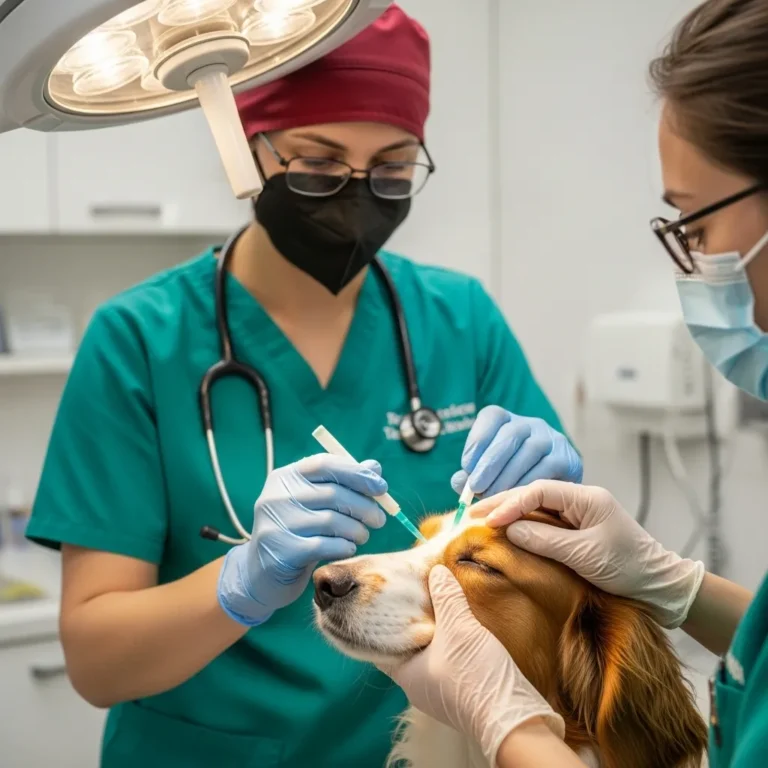
Author: DogsBlogSS Team
⚠️ Disclaimer: This article is for informational purposes only and is not a substitute for consulting a veterinarian.
Understanding dog ear hematoma
What exactly is a dog ear hematoma?
Imagine gently touching your dog’s ear only to feel a soft, squishy swelling under the skin. That’s often what a dog ear hematoma (also called an aural hematoma) feels like. Essentially, it’s a pocket of blood that has collected between the skin and cartilage of the ear flap (the “pinna”). It’s not just a bruise: the blood doesn’t immediately go away. Unless treated, it can stick around and even cause permanent changes to the shape of the ear, sometimes leading to a “cauliflower” appearance.
Veterinarians describe this as a pretty painful condition — not just for the ear itself, but emotionally, for both dogs and their humans. It can develop quickly, and while it’s treatable, awareness and prompt action make a big difference.
What causes an aural hematoma in dogs?
According to dogster: A dog ear hematoma usually comes from trauma — but trauma here doesn’t necessarily mean a big accident. More often, it’s the little things: repeated head shaking, scratching, or chronic ear irritation. When a dog vigorously shakes their head, tiny blood vessels in the ear flap can rupture, and blood leaks out, pooling between tissues.
Underlying conditions often feed into the problem. According to veterinary experts, common culprits include:
- Ear infections (especially bacterial or yeast)
- Allergies, which cause itching and scratching
- Ear mites
- Skin diseases
- In rare cases, clotting disorders
If these root issues aren’t addressed, the hematoma may keep coming back, or healing may be complicated. Dogster highlights this risk, explaining that sometimes the hematoma points to a deeper, unresolved ear problem.
Are some dog breeds more prone to ear hematomas?
According to insuranceopedia: Yes — some dogs are simply more at risk. Breeds with long, floppy ears seem to be particularly vulnerable because their ear flaps wobble more during head shaking or scratching. According to Insuranceopedia, breeds such as Cocker Spaniels, Basset Hounds, Beagles, and even Saint Bernards are among those more commonly affected
Aside from anatomy, if a breed is more likely to develop ear infections or allergies, that can indirectly raise the risk too.
What are the signs and symptoms of an ear hematoma in a dog?
According to caninejournal: It’s not hard to spot, once you know what to look (and feel) for. Key signs include:
- A soft swelling or bulge on one or both ear flaps
- The ear feels spongy or warm to touch
- Your dog may be shaking their head frequently
- Scratching at the affected ear
- Tilting their head to one side
- The ear might look discolored or bruised
Beyond the physical swelling, dogs may act uncomfortable. They might resist having you touch the ear, or seem more irritable than usual. As Canine Journal shared, these signs are common in many cases — and that squishy mass is often a give-away.
How can I tell the difference between an ear hematoma and other ear problems?
Great question. Not every ear swelling is a hematoma. Some other ear issues might mimic similar signs, such as:
According to VCA Hospitals:
- Ear infections: Swelling might come from inflammation, pus, or fluid, but not necessarily a blood pocket.
- Abscesses or tumors: Rare but possible; lumps could be solid instead of fluid-filled.
- Trauma-related swelling: A bite or injury could cause swelling, but the pattern and feel might differ.
What helps is a veterinary exam — your vet can gently press the ear, feel for fluid pockets, and determine if the swelling is likely blood-filled (hematoma) or something else. They may also check for infection, mites, or underlying causes.
Diagnosis and Initial Steps
How is a dog ear hematoma diagnosed by a vet?
When you bring your dog in, here’s what typically happens:
According to hepper:
- Physical Examination: The vet will examine the ear flap, palpating it to feel for fluid pockets.
- Ear Swabs (Cytology): They might take a swab from the ear canal to check for infection, yeast, or mites under a microscope.
- Blood Work: Sometimes needed before anesthesia (if surgery is planned) or to assess for clotting disorders.
- Allergy Testing: If chronic ear shaking or infections are to blame, underlying allergies might be investigated.
According to cliniciansbrief: Depending on the case, a vet may also insert a drain or cannula to assess fluid over time. A veterinary clinic (Scottsdale Veterinary Clinic) describes cannula placement as an option for certain hematomas.
What should I do if I suspect my dog has an ear hematoma?
If you notice the swelling, try not to panic — but do act. Here’s a simple step-by-step:
- Call your vet – Let them know what you’re seeing and feeling. Try to bring a photo if possible.
- Avoid too much touching – While it’s tempting to massage or press the area, resist: you don’t want to cause more damage or stress.
- Restrict scratching/shaking – Use an Elizabethan collar if needed, to prevent further injury.
- Prepare for a visit – Your vet will want to examine, maybe run tests, and discuss treatment options with you based on how severe and fresh the hematoma is.
Can a dog ear hematoma resolve on its own without veterinary intervention?
According to insuranceopedia: In some cases, yes — but it’s risky. Without intervention, the body may gradually reabsorb the blood. However, this process can take weeks to months, and there’s a catch: during healing, there’s a high chance of scar tissue forming, which can distort the ear.
According to insuranceopedia: The end result might be a permanently deformed ear (sometimes called “cauliflower ear”). And while some dog owners might be okay with the cosmetic change, many dogs may experience ongoing discomfort, or the hematoma could return, especially if the root cause (like an infection or allergy) wasn’t treated.
dog ear hematoma treatment
What are the different treatment options for a dog ear hematoma?
Broadly speaking, the treatments fall into two categories:
- Surgical interventions
- Non-surgical or minimally invasive approaches
Your vet will recommend the best method depending on how large the hematoma is, how long it’s been there, and how healthy your dog is overall.
Is surgery always necessary for an ear hematoma?
According to insuranceopedia: No — surgery is common and often effective, but it’s not always the first or only choice. For some dogs, especially if the hematoma is small and recent, non-surgical options may work well. That said, surgery tends to reduce the risk of recurrence.
Veterinarians often prefer surgery when they want to prevent permanent ear deformation and reduce the need for repeated treatments.
What does ear hematoma surgery involve?
Here’s a typical surgical picture, based on what veterinary professionals describe:
- According to hepper: Under general anesthesia, the vet makes a small incision in the swollen part of the ear to drain the blood and remove clots.
- According to canine journal: The ear flap is sutured (stitched) so that the skin and cartilage reattach and scar tissue is minimized.
- According to Hepper : Sometimes a drain (cannula) is left in place to allow fluid to escape while healing.
- According to hepper: The ear is bandaged or strapped to the head to stabilize it and prevent more trauma.
- According to hepper: After surgery, your dog will likely go home with medications — pain relief, anti-inflammatory drugs, maybe antibiotics — and probably an Elizabethan collar to stop scratching.
- According to hepper: Follow-up visits are needed: for example, stitch removal often happens about 2 weeks later, depending on healing.
What are the non‑surgical treatment options for ear hematomas?
If surgery isn’t ideal, or if the hematoma is mild, other approaches may work:
According to the pet vet:
- Needle Aspiration: A vet draws blood out with a syringe. This can be done without full anesthesia in some cases. However, the problem is that many hematomas refill quickly, sometimes multiple times.
- Steroid Injection: After aspiration, a vet may inject corticosteroids into the space to reduce inflammation and discourage fluid return.
- Oral Medications: These can include anti-inflammatories, steroids, painkillers, and antibiotics (if infection is present).
- Compression Bandaging: Holding the ear close to the head with a gentle, firm wrap helps prevent fluid from pooling again.
- Home Supportive Care: While not a complete fix, some pet owners use natural anti-inflammatory supplements (like omega-3s), or safe topical compresses (cold early, warm later) to support healing.
That said, these strategies often require commitment — frequent vet rechecks, careful bandaging, and close monitoring.
how to treat dog ear hematoma at home?
While home remedies alone usually aren’t enough to cure a large or serious hematoma, they can support recovery in milder cases. Some complementary approaches include:
According to Vet Explains Pets:
- Cold compresses in the first day or two to reduce initial swelling
- Transitioning to warm compresses after that to encourage absorption
- Natural anti-inflammatory supplements like omega-3 fatty acids
- Gentle herbal support (under your vet’s guidance), such as arnica (though it’s not a substitute for medical treatment)
But — and this is important — these are not a substitute for veterinary care. Hematomas involve blood accumulation, and without proper drainage and treatment, there’s a real risk of pain, infection, or permanent scarring.
What is the typical cost of treating a dog ear hematoma?
Prices can vary quite a lot depending on where you live, your vet, the severity of the hematoma, and what treatment method is used. Here’s a breakdown based on several sources:
- According to vety: According to VETY, average surgery costs range from $500 to $2,500.
- According to dogster: Dogster estimates roughly $300 to $2,000, depending on method and region.
- According to forbes: Forbes Advisor emphasizes that costs depend on factors like vet experience, your dog’s size, and the surgical tools used (e.g., laser vs. standard surgery).
- According to the pet vet: From The Pet Vet, less-invasive treatments (like aspiration or steroids) can be less expensive initially, but frequent re-aspiration or recurrent hematomas may make the total cost climb.
Because of this variability, it’s wise to ask your vet for a detailed cost estimate, breaking down things like anesthesia, hospitalization, medication, and follow-up care.
Post‑Treatment and Recovery
What is the recovery time after ear hematoma surgery?
According to petscare: Recovery after surgery typically takes 2–4 weeks, though full healing and cosmetic recovery may take a bit longer.
Here’s a rough timeline:
- Days 1–3: Pain management, monitoring, bandaging, and keeping your dog calm
- According to petscare: Around Day 3 to 14: Removal of drains or suture checks, depending on the method used
- Week 2–4: Stitch removal (if needed), final checkups, and more freedom to return to normal activity (as cleared by your vet)
How do I care for my dog’s ear after treatment?
Good post-care is crucial. Here’s what to do:
According to PetMD:
- Follow your vet’s instructions exactly — medications, rechecks, wound care.
- Use the Elizabethan collar as directed to prevent scratching or shaking.
- Keep bandages clean and dry; change them if your vet advises.
- Limit your dog’s activity initially — calm walks, no rough play — so the ear isn’t bumped.
- Monitor for signs of reinjury or infection: swelling, discharge, redness, or changes in behavior should prompt a call to your vet.
What are the potential complications after an ear hematoma is treated?
As with many medical procedures, there are risks. Some possible complications include:
According to PetMD:
- Recurrence: The hematoma might come back, especially if the underlying cause (like an infection) wasn’t fully treated.
- Infection: Particularly if drains or sutures are present.
- Scar tissue: If healing isn’t smooth, there can be fibrosis or cosmetic deformity (“cauliflower ear”).
- Hematoma failure to resolve: In some cases, pockets persist or fluid re-accumulates.
That’s why a careful follow-up schedule with your vet is so important.
Can ear hematomas reoccur after treatment?
According to forbes: Yes — and that’s one of the biggest concerns. Recurrence is more likely if the real trigger (ear infection, mites, allergies) wasn’t addressed. According to Forbes Advisor, even after surgical repair, there’s a chance that a new hematoma could develop if head-shaking or irritation continues.
Veterinarians often emphasize the importance of treating the root cause, not just the swelling, to lower the risk of repeat episodes.
Prevention
How can I prevent my dog from getting an ear hematoma?
Preventing a dog ear hematoma often means managing the conditions that cause it in the first place. Here are some ideas:
According to PetMD:
- Address ear infections early: Don’t ignore scratching, head shaking, or unusual discharge — these may lead to hematoma if left unchecked.
- Control allergies: Whether through diet, medication, or environmental adjustments, minimizing allergic reactions helps reduce ear irritation.
- Regular ear check-ups: Keep your dog’s ears clean (as advised by your vet) and let your vet examine them periodically, especially for breeds prone to infections.
- Trim ear hair (if your breed has long hair inside the ears): This improves airflow and reduces moisture buildup.
- Discourage vigorous head shaking: While you can’t stop it entirely, keeping ear issues under control helps reduce the triggers for shaking.
What role does ear hygiene play in preventing hematomas?
Ear hygiene is often the unsung hero. Here’s how it helps prevent hematomas:
According to akc:
- Cleaning: Regular (but gentle) cleaning removes wax, debris, and moisture, which can contribute to infections.
- Drying: Moisture breeds yeast and bacteria — but a well-dried ear flap is less likely to get irritated.
- Monitoring: When you clean, you also inspect — spotting early redness, swelling, or discharge can let you act before things escalate.
Good hygiene combined with proactive vet care helps lower the risk of the inflammation and trauma that lead to hematoma dog ear.
In the Words of Experts
According to the pet vet: Veterinary experts consistently emphasize early intervention. For example, The Pet Vet notes that aspiration and compression can work in small, early hematomas, but regular rechecks and addressing underlying causes are key to success.
According to the pet vet: Meanwhile, cost guides from VETY and Forbes Advisor highlight that the choice between treatments — whether surgery or non-surgical — comes down to balancing long-term effectiveness, risk of recurrence, and financial investment.
Final Thoughts
Discovering a soft, swollen ear flap on your dog can feel alarming — but it’s not the end of the world. Many dogs recover beautifully from ear hematoma dog, especially with timely veterinary care. The key is to act sooner rather than later, understand the treatment options, and commit to follow-up and prevention.
If you’re ever in doubt about what’s going on in your pup’s ears, reach out to your vet — they’re the best guide. And remember, with the right care, your four-legged friend can get back to shaking their tail (and head) worry‑free.
Notice : The DogsBlogSS editorial team is dedicated to providing accurate, research-based information about dog health, behavior, and care. All our articles are fact-checked using trusted veterinary sources such as VCA Hospitals, Merck Vet Manual, and the AKC.
you may like it








